Do you have a question about the MUTOH XPJ-661UF and is the answer not in the manual?
Provides an overview of the printer's basic functions and initial setup.
Details the key physical parts and their functions.
Outlines the software and hardware components that work together.
Explains how to access and configure printer driver settings.
Covers the operation of the printer monitoring software.
Details launching LFP Finder, Layout & Print Tool 2, and Layer Editor.
Specifies the types and dimensions of media compatible with the printer.
Highlights essential safety and operational guidelines for product use.
Describes the procedure for powering the printer on and off.
Explains how to activate and manage the printer's power-saving sleep mode.
Covers the fundamental process of printing with the device.
Details the steps for correctly placing media onto the printer's table.
Explains how to check and maintain print head nozzle condition.
Guides users through the process of initiating a print job.
Describes how to temporarily stop and resume active print jobs.
Explains how to terminate an ongoing print job.
Lists available menu options during active print operations.
Details how to verify the print area on the media before printing.
Describes how to apply extra UV curing for improved ink drying.
Explains how to adjust the table height for optimal print quality.
Introduces the capability of printing in multiple layers.
Provides an introduction to advanced printer operations.
Explains how to navigate and use the printer's control panel buttons.
Describes how to access and utilize the printer's setup menus.
Allows configuration of various printer settings.
Manages user-defined profiles for media and print settings.
Selects the printing speed and quality mode.
Optimizes print quality through adjustment patterns.
Calibrates media feed for accuracy.
Configures the vacuum table's suction power.
Configures media placement conditions like size and origin.
Adjusts printing speed for enhanced quality on certain media.
Visualizes the print area on the media before printing.
Configures printer response to detected obstacles.
Copies user settings to other profiles.
Resets selected settings to factory defaults.
Performs diagnostic prints for print head and system checks.
Checks for clogged or missing nozzles in the print head.
Performs a nozzle check with a colored background for clarity.
Prints using selected user type settings for confirmation.
Prints a list of current printer settings and user types.
Executes a color demonstration print.
Accesses various printer maintenance functions.
Performs print head cleaning procedures.
Resets the waste ink counter to zero.
Facilitates replacement of the CR cleaning wiper and absorption material.
Performs additional UV curing on printed media.
Discharges ink from the printer, typically before moving.
Calibrates the table height for optimal printing.
Moves the table to a secure position for transport.
Performs automated table maintenance.
Executes routine daily maintenance tasks.
Displays current printer status and information.
Shows the remaining ink levels for each cartridge.
Displays the estimated service life of printer components.
Provides information on the status of print jobs.
Shows the printer's firmware version.
Displays the printer's unique serial number.
Indicates the total area printed by the printer.
Information regarding optional accessories.
Details on attaching the Rotary Unit option.
Manages the printer's power-saving sleep mode settings.
Activates the printer's sleep mode.
Sets the timer for automatic head cleaning during sleep mode.
Visual guide to the printer's menu structure.
Overview of the printer's maintenance procedures.
Guidelines for wearing protective gear during maintenance.
Instructions on how to agitate ink cartridges to prevent settling.
Procedures for monitoring ink levels and replacing cartridges.
Steps for draining and emptying the waste ink tank.
Details the process of performing daily maintenance.
Outlines the sequence of daily maintenance steps.
Lists the necessary items and preparation for daily maintenance.
Step-by-step guide for executing daily maintenance.
Instructions for cleaning the UV-LED lamp.
Guide for moistening the print head nozzles.
Steps for cleaning the area around the print head.
Procedures for cleaning the wiper and cap area.
Final steps to complete the daily maintenance routine.
Explains how to perform head cleaning to resolve nozzle issues.
Details on cleaning specific parts used in daily maintenance.
Steps to prepare the printer for daily maintenance.
Instructions for cleaning the maintenance parts.
Final steps to conclude the maintenance process.
General cleaning procedures for the printer's interior.
How to clean the printer's media table.
How to clean the table's guide rails.
Performing maintenance on the printer's table mechanism.
Guides on replacing consumable components.
Steps to replace the flushing box absorption material.
Instructions for replacing the cleaning wiper.
Procedure for replacing the UV-LED lamp window glass.
Steps for replacing the UV-LED lamp filter.
Instructions for safely moving and transporting the printer.
Procedures for preparing and moving the printer.
Guidelines for packing and transporting the printer.
Draining ink before transportation.
Adjusting the table for secure packing.
Steps for packing the printer for transport.
Instructions for setting up the printer after transportation.
Guides initial ink charging after draining or replacement.
Lists and explains status and error messages.
Displays current operational status messages from the printer.
Lists error messages and their corresponding solutions.
Details critical errors that require printer restart.
Provides guidance for resolving printer malfunctions.
Solutions for issues during initial setup.
Addresses problems encountered during printer startup.
Solves issues related to media detection and handling.
Addresses problems with the printer's table movement or noise.
Solutions for print quality and positioning issues.
Lists the technical specifications of the printer.
Detailed technical data for the product.
Information on available options and supply items.
Records changes and updates made to the manual.
| Power Requirements | AC 100-240V, 50/60Hz |
|---|---|
| Maximum Print Width/Area | 1625 mm (64 inches) |
| Print Resolution | 1440 x 1440 dpi |
| Ink Type | UV ink |
| Media Thickness | up to 50 mm |
| Ink Colors | C, M, Y, K, W, V |
| Interface | USB, Ethernet |
| Printing Technology | UV LED Inkjet |
| Weight | 209.4 lbs (95 kg) |
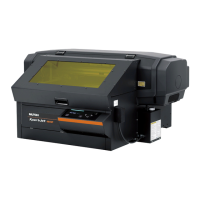
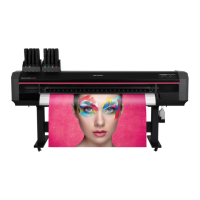
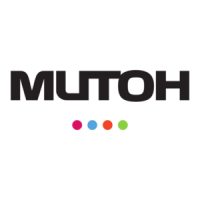

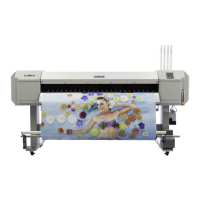
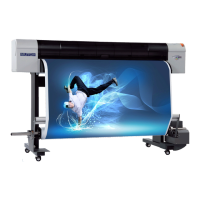
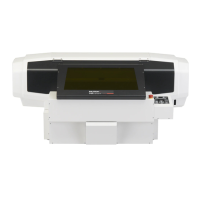
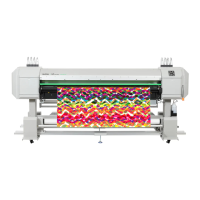
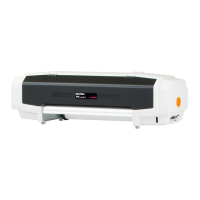
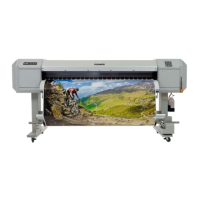
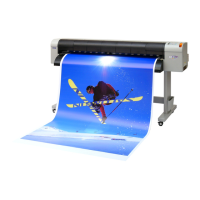
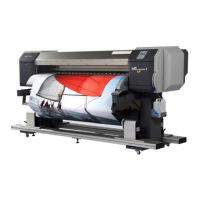
